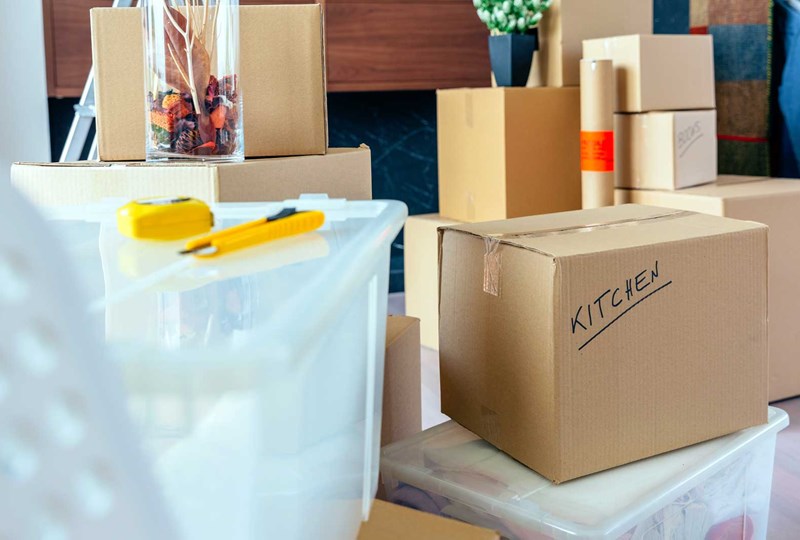
While it may seem like an enormous task to pack up your entire life, try not to overthink the process of packing and moving. Here, we’re sharing hot tips from moving experts that will ensure your move from one residence to another goes off without a hitch. And, we’re including money-saving tips so you don’t have to pay an extra dime!
From the moving timeline to tips on bubble wrap alternatives, here’s everything to consider when packing and moving.
6 Moving tips
If possible, prepare for the big move as early as possible. By prepping your family members and space in advance, you’ll set everyone up for success and avoid the potential headaches that could come from a lack of planning.
Plus, keep in mind that getting ready for a move includes more than just packing. For example, garage sales and utility transfers are also important steps. Keep reading as we dive into the top moving hacks and tips.
Have a garage sale
Even before you begin packing your belongings, consider hosting a garage sale where you can flip items that you no longer use. This will help you pare down the amount of stuff that you need to pack and transfer, which ultimately simplifies your moving process.
Here’s how to have a successful pre-move garage sale:
- Advertise your sale around the neighborhood and on social media.
- Offer items sold in bundles.
- Set fair prices to get more sales.
- Prepare plenty of change, or offer online payment options like Venmo or Paypal.
Start packing early
Once you’ve gotten rid of any excess items that won’t be coming along for the move, it’s time to pack up the belongings that will trek from one home to the next. While it’s best to start packing as soon as possible, you’ll want to keep your most-used items out until closer to your move date.
According to Edina Realty’s ultimate moving checklist, it’s ideal to start the packing process around six weeks before the move.
Finish packing the day before the big move
While gathering boxes to pack your belongings, remember that you won’t want to pack up your favorite kitchen utensils, daily toiletries, or beloved jackets until much closer to the move. It’s ok to still be packing all the way up until the day before the move, as long as you don’t leave the bulk of the packing to the last minute.
Schedule your utilities
Most utility companies can process a request for new services quickly, but it’s a smart idea to plan your utilities — both a service termination and initiation – a couple of weeks prior to your move. Making the extra call or completing an online application for utilities now will make the transition of moving much smoother later. And, the good news is, this step should only take a few minutes out of your day, but the payoff is substantial. All you have to do is:
- Make a list of all of the utilities you currently use.
- Contact your providers and update them with your change of address.
- Pay off any current balances.
- Schedule your new service to begin a day prior to your move, and your previous service to end a day after your move (so you don’t have a lapse of time without water or electricity at either place).
Working with Edina Realty? Talk to your agent about Updater, our moving partner who can help you automatically update your address, change your utilities and more.
Set a moving budget
When moving, some homeowners start to rack up significant bills. It’s a good idea to prepare your finances in advance so you’re ready when the moving day comes. The price of the following tends to add up to a few thousand dollars for most movers:
- Base fee with a moving company
- Extra fee for specialty items (think oversized or extra fragile pieces)
- Renting your own moving truck
- Purchasing moving equipment, including boxes and tape
- Transportation from your sold house to your newly purchased home
- Storage units (especially if you opt for temporary transitional housing)
- Booking a sitter for your pets or children
Eat what’s in your cupboards
Aside from purchasing a light amount of produce and other perishables, try to hold off on grocery shopping before your move. Eating what’s in your cupboards will mean you have fewer items to transport on moving day.
However, if you have a large spice collection or are hoping to move everything in your kitchen and pantry, you still can. Here are some food packing hacks for moving:
- Pack dry food goods in plastic boxes to keep pests out.
- Move refrigerated items only if your new location is less than 2 hours away.
- Donate any food that can’t be taken with you, rather than throwing it out.
5 Packing tips
Packing can seem daunting. These methods to pack for moving will help simplify your process, while making sure all of your belongings make it to your new property safely.
Label everything
Attach a label to every box you pack. Not only will this help you identify what’s in each box, but it will also help your movers (whether a professional company or helpful friends) know where in your home to organize the boxes.
You can also come up with an easy color-coded system for each room in your new house, then label each box or bag with the correct color. Here are some materials that you likely have around your home already that work well for color-coding boxes:
- ashi tape
- Colored markers
- Pieces of colored paper
- Stickers
The best way to pack clothes for moving
Most of us don’t have enough garment bags to house all the clothing items in our closets, but it’s a waste of time to pack up each button-down shirt, dress and pair of pants into boxes. Instead, the best way to pack clothes for moving is to turn a plastic garbage bag upside down and make a small hole in the middle. Hook a group of 10 hangers into the opening, then seal the “top” of the bag using the bag’s original strings.
Voila! Now you can transport closet items with ease.
Switch peanuts and bubble wrap for clothes
When packing up your dinnerware, picture frames or other breakable items, you’ll want to protect them. And, it’s possible to keep these fragile items safe without spending a fortune on bubble wrap.
If you have unused Styrofoam party plates, layer them between breakables as you pack. Or, consider separating and wrapping fragile items with the following:
- Clothes
- Cloth napkins
- Tablecloths
- Placemats
- Towels
The best way to pack shoes for moving
To maintain the condition of your shoes, you’ll want to follow these moving tips and tricks for shoes:
- Place heavier shoes at the bottom of the box.
- Wrap nicer shoes in a plastic bag, or keep them separated in their own box.
- Tie pairs with laces together.
- Stuff shoes with socks to maintain their shape — and save room.
How to pack a TV for moving
A television is typically a higher-ticket item, so you’ll want to take care when packing it. Ensure the screen doesn’t crack throughout the move by wrapping the TV generously with bubble wrap, packing paper or a blanket. Then, place the TV in the original box if you have it. Otherwise, use both a packing blanket and stretch wrap to secure the device.
Before you dismantle your TVs, computers or other electronics, take pictures of the cords behind them and how they interact with one another. Setup at your new home is a breeze when you have a visual guide for how to best connect your devices.
Packing and moving FAQs
Do you still have some lingering questions about packing and moving? Keep reading for answers to some of the most common packing- and moving-related questions.
How many boxes do I need to move?
The number of boxes needed to move varies based on the number of people living in a home and the number of belongings they have. However, our partners at Updater have come up with some general guidelines for how many boxes your move may require.
For a 1,700-2,200 square foot house, the moving experts recommend you acquire:
- 38-42 small boxes
- 36-47 medium boxes
- 21-26 large boxes
- 13-15 extra-large boxes
They have also calculated the number of boxes that are typically needed for smaller homes and for each room in the house.
When should I start packing to move?
While every move is different, it’s generally suggested to begin packing around six weeks before a move. However, it doesn’t hurt to begin packing as soon as possible, as long as your most-used items stay out of the moving bins until the transition is closer.
Where do I start when packing to move?
It’s typically helpful to begin the moving process in the basement or the attic. These areas are likely filled with storage already, making it easier to pack up the items that you plan to transport. These rooms also tend to accumulate extra clutter, so keep your eye out for items to discard rather than pack.
Explore Edina Realty’s insights for more great tips and advice
These moving and packing hacks are bound to make your moving experience flow with ease. If you’re ready to move, contact one of our local real estate experts to get advice on buying or selling a home in Minnesota or western Wisconsin. By reaching out to Edina Realty or your agent, you’ll receive extra packing and moving advice from a REALTOR® as you prepare for your move.









